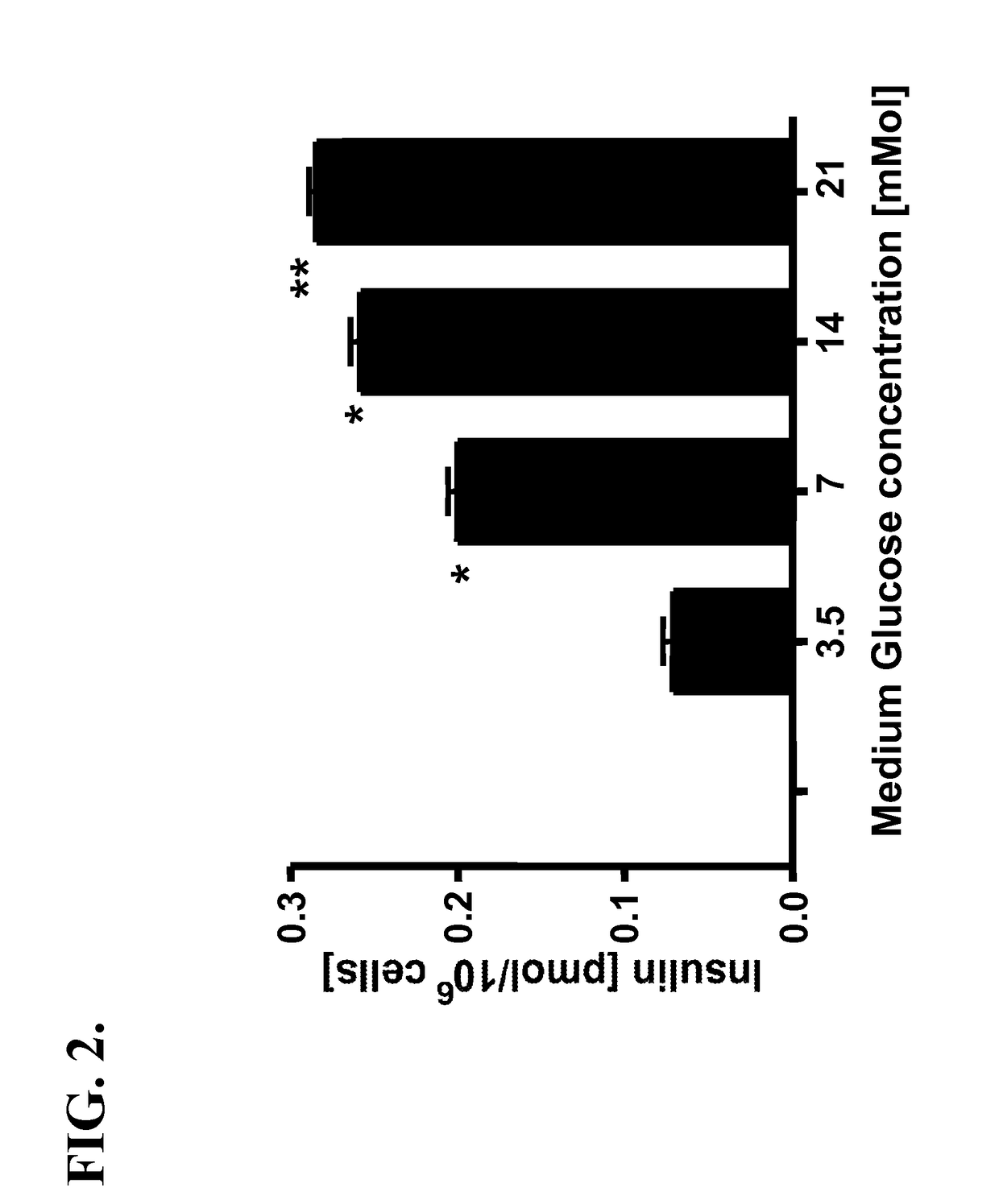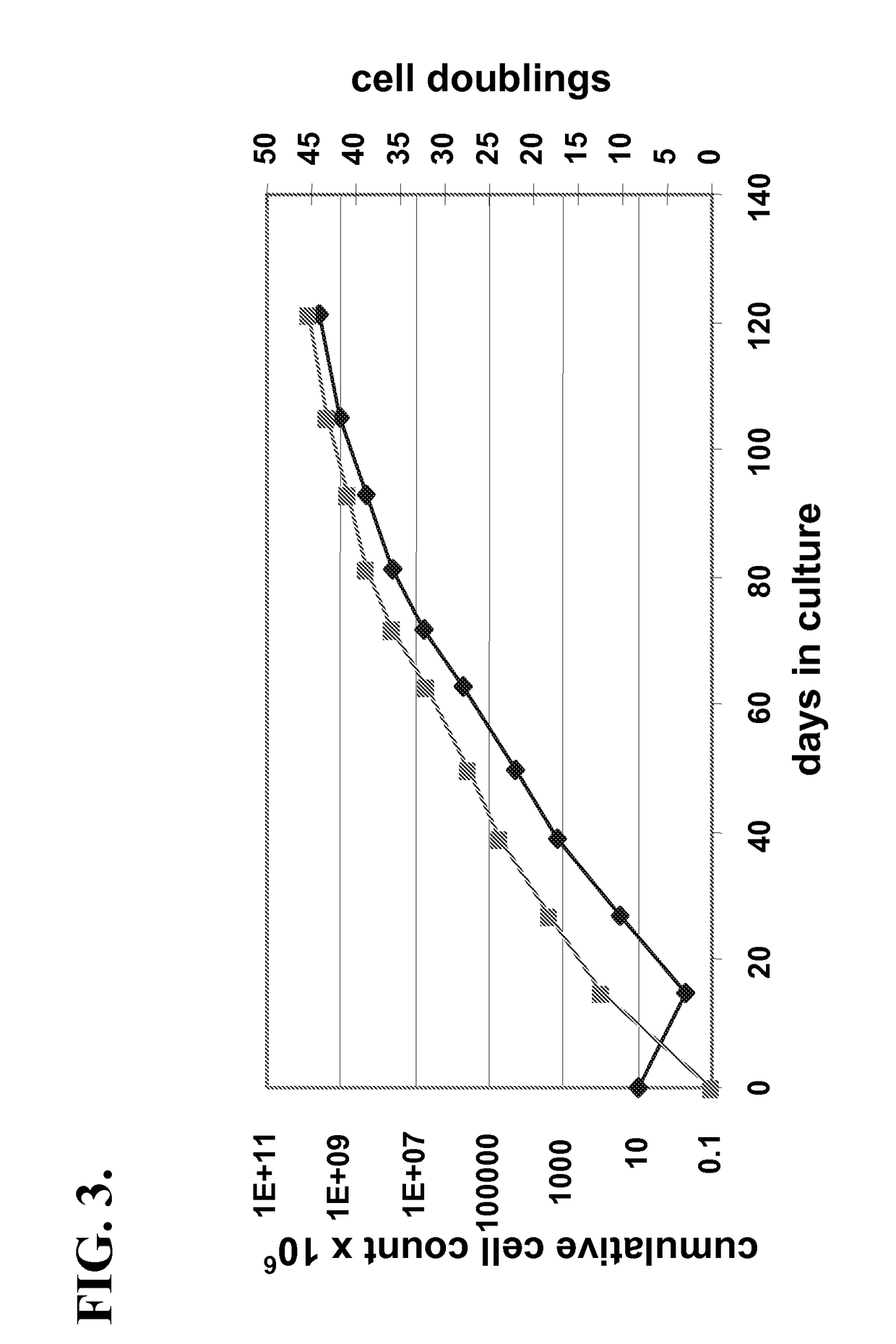Marrow stem cell and pancreatic beta cell fusion cell useful for the treatment of diabetes
a fusion cell and pancreatic beta cell technology, applied in the field of biotechnology and therapies, can solve the problems of malignant transformation or cellular instability, and achieve the effect of easy repeated and/or augmented expansion, and wide expansion in vitro
- Summary
- Abstract
- Description
- Claims
- Application Information
AI Technical Summary
Benefits of technology
Problems solved by technology
Method used
Image
Examples
example 1
Protocol for Isolation and Fusion of PβC with MSC: Generation of β-MSC
[0030]Isolation of islets from male mouse pancreata was performed as follows: mouse pancreata were treated with collagenase XI; the resulting cells were separated from debris via a ficoll gradient; live cells were hand picked and plated. Cells were later stained to confirm presence of PβC.
[0031]PβC were isolated from the islet cell culture via exposing the above cultures to trypsin-EDTA for 3 minutes and removing the cells that were no longer adherent.
[0032]Syngeneic female MSC (immortal) were grown from mouse bone marrow using techniques for MSC isolation known in the art.
example 2
Determine the Ratio of MSC and Pancreatic β Cells (PβC) for Optimal Cellular Fusion
[0033]Starting with a 1:1 ratio of co-cultured isogeneic MSC and isolated PβC from mice ˜50% of cells were fused (PβC fused with MSC) as confirmed by the use of distinct vital dyes for each cell type, by FISH for the “Y” chromosome (male-derived MSC, female-derived PβC), RT-PCR, Westerns, and immunocytochemistry. In addition, Ficoll gradient centrifugation and FACS analysis corroborated the extent of cell fusion accomplished in co-culture. In additional studies, initial cell ratios in co-culture will be varied (up and down) in order to assess whether the extent of cell fusion can be further optimized.
[0034]PβC and MSC were co-cultured at ratios of 1:1 and 2:1. Fusion was induced by phytohemagglutinin and by changing the medium to polyethylene glycol (45% w / v) for 1 minute and then washing. Cells were then cultured for 24 hours before being removed by treatment with trypsin-EDTA and replated. Hybrid co...
example 3
Determine the Ability of β-MSC to Physiologically Release Insulin in Culture
[0035]Freshly fused β-MSC that were not passaged in culture were isolated by FACS or Ficoll gradient centrifugation. β-MSC express insulin by RT-PCR and ELISA (secretion into media). Glucose concentrations in serum free media were adjusted to 0 and gradually raised to 50, 100, 250, 500 and 750 mg / dL (45 minutes at each concentration). Media concentrations of insulin and C-Peptide were determined at the end of each 45-minute period by sensitive ELISA assays, showing a glucose level-dependent rise of both. Cells adapted to 750 mg / dL of media glucose were then exposed to the reverse pattern of glucose concentrations in the media, showing a step wise fall in insulin and C-Peptide levels. Native MSC do not secrete insulin or C-Peptide, while PβC per se respond to changes in ambient glucose levels in a pattern identical to that of fused cells.
[0036]FIG. 2 depicts insulin release from β-MSC treated with glucose con...
PUM
| Property | Measurement | Unit |
|---|---|---|
| concentrations | aaaaa | aaaaa |
| concentration | aaaaa | aaaaa |
| concentration | aaaaa | aaaaa |
Abstract
Description
Claims
Application Information
 Login to View More
Login to View More - R&D
- Intellectual Property
- Life Sciences
- Materials
- Tech Scout
- Unparalleled Data Quality
- Higher Quality Content
- 60% Fewer Hallucinations
Browse by: Latest US Patents, China's latest patents, Technical Efficacy Thesaurus, Application Domain, Technology Topic, Popular Technical Reports.
© 2025 PatSnap. All rights reserved.Legal|Privacy policy|Modern Slavery Act Transparency Statement|Sitemap|About US| Contact US: help@patsnap.com



